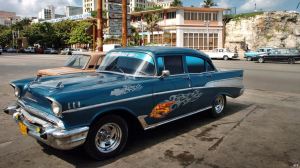Juan Juan Almeida, 11 May 2015 — With the relaxation of relations between the United States and Cuba, speculation has been unleashed and is causing mischief. Some experts guarantee that several U.S. companies are ready to buy the famous “almendrones”* on the island. It could be the arrangement is real; there is always some nostalgic person whose passion, need or disinformation makes him confuse reality with desire or imagination.
Absolutely out of focus, Cuba’s automotive heritage has been virtually plundered. Most of what remains – Cadillacs, Chevys, Studebakers, Pontiacs, Thunderbirds and Buicks – which still circulate on the island, had their engines replaced to be used as collective taxis (“boteros”), and upon losing originality, they also lost their exceptionalism.
In the middle of the ‘80s, the Cuban business, At the Service of Foreigners (CUBALSE, for its acronym) capitalized on the large amount of collectible cars that existed in the country. It acquired them by referring to their technological importance (Spanish-Swiss, 1930 Cadillac V16), 1918 Ford T, 1930 Baby Lincoln), or their universal historic significance.
I don’t think it’s necessary to explain that CUBALSE bought them at laughable prices; for a Mercedes-Benz 300 SL Gullwing, or a Jaguar or Bugatti, it paid with Russian vehicles.
Several of these rolling jewels are found today in the Automobile Museum located on Oficios Street in Old Havana; others, like “The Little Pink Shoes”** are guarded and excellently maintained in the private garages of the upper elite. The rest were sold at very good prices, mostly to Swiss collectors.
At the end of the ‘90s, there were almost no cars on the island of the 100 percent original collection in the hands of the population. CUBALSE stopped buying, and the baton of patrimonial rape passed to an exclusive group of artists, who didn’t sell their works at the prices they do now but knew how to cash in, with more than innate talent, on their government connections in order to buy antique autos, adorn them with four strokes and, under the status of “work of art,” take them out of the country and sell them in the exterior.
Thus, by sea, like rafters but with special permission, American cars left Cuba at the request of a foreign market that demanded, fundamentally, 1946 Chevrolet trucks, 1941 Ford Mercurys, 1956 Buick Roadmasters, Chevrolet Corvettes and 1957 Chevys.
In the craze for antique four-wheelers, Cubans and foreign residents with commercial vision came together. Then, with an economic option, the Government retook the business with companies like Cubataxi, which acquired antique cars with a certain national history, not to sell but rather to rent, at the price of a prostitute, to tourists who would pay to ride a Harley Davidson that Camillo Cienfuegos used, the Chevrolet Impala that belonged to Almeida, and what some say is only a fake version of the Chaika limousine*** that Fidel used for years.
Putting together these simple pieces of the commercial puzzle of the car in Cuba, it’s very easy to understand that, of the almost 60,000 antique cars that still circulate on the island, with certain isolated exceptions, in the possession of some nationals there remain only hybrid autos, armed with the loose criteria of an ingenious mechanic, which of course he could sell, but they are not even approximately the gold mine that their owners believe they are.
Translator’s notes:
*“Almonds,” because of their shape.
”**A poem by José Martí that school children learn and that often is satirized.
***A Soviet brand car.
Translated by Regina Anavy

